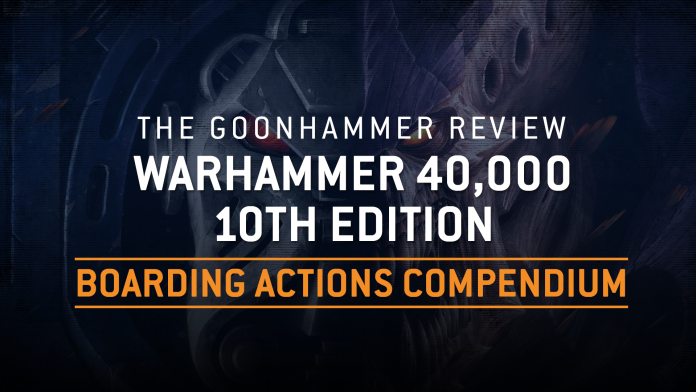After more than a year of (at least half) our Boarding Actions terrain gathering dust, we finally have updated rules for playing one of our favorite game modes in 10th edition. And ladies and gentlemen let’s just get this out of the way up front: GW absolutely delivered here – and they delivered hard. The rules see a bit of a glow up outside their translation to 10th and there’s a whole slew of new faction rules to play with.
We’d like to once again thank Games Workshop for providing us with a preview copy of the book for review purposes.
The Video Version of this Review
Want to watch or listen to his instead of Reading? you can find our video review here:
What’s New From Last Edition
Boarding actions is back in 10th edition form, but it’s largely the same format you played if you engaged with it last edition albeit with a few changes. Here’s some highlights:
- Detachments: Instead of just having limitations on what you can bring in your army and special changes to make rules work on space ships, you have a selection of detachments to take with different detachment rules, stratagems, and specific units you can take.
- White Dwarf Missions are Out: While this book has all the missions from the Arks of Omen books last edition, the White Dwarf ones are noticeably absent. They can likely be adapted to this format however if you want to do some extra work. We’re also secretly hoping they get re-released as another Compendium soon.
- Fly is Allowed: A lot of units with fly were not allowed on spaceships last edition. This ruleset allows a lot more fly units to see the table, but their movement is reduced to 9”
- Scouting is Not: All units lose their pregame moves if they have them.
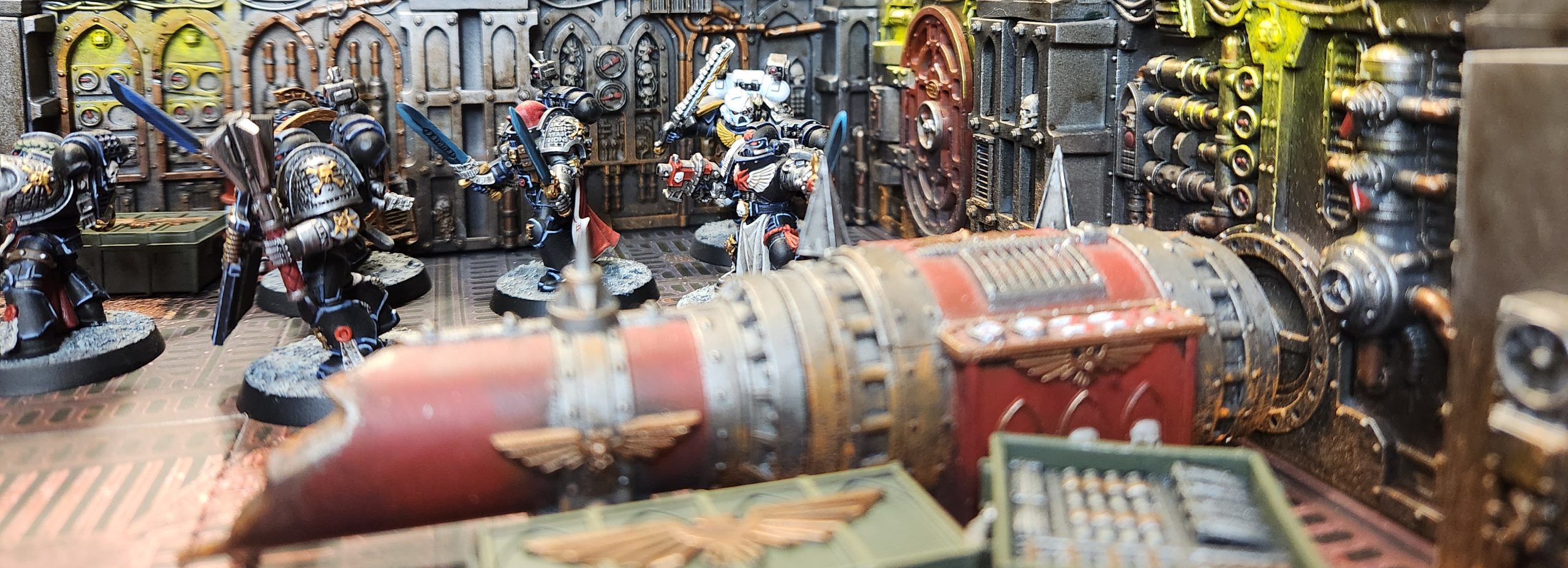
How is Boarding Actions Different Than Normal Warhammer?
While Boarding Actions is essentially Warhammer 40,000 tenth edition at its core, there are a few carve-outs and rule changes which change how the game plays and feels. For one all games are limited to 500 points using the most recent Munitorum Field Manual (although you don’t use the Dataslate for these games). Games all take place on a smaller board – 28″x 48″ – and the terrain layouts are constructed per mission using the Gallowdark Terrain. This means that play in Boarding Actions takes place in tight corridors, allowing for fast-paced, close-range encounters.
In addition to what you’re playing on, there are several changes to how you play. A big part of fighting on a ship is moving from room to room so there are plenty of rules for operating and fighting through hatchways. Things are more crowded as well, so models now block visibility and movement, even to their own units. Measurement also changes; instead of measuring point to point you generally will measure the path around walls or closed hatchways, making it that much harder to affect things around the corner. The only exception to this is measuring distances for setting up from Deep Strike.
In the Shooting Phase you can only draw line of sight by drawing lines to the target’s base without crossing walls, hatchways or other models. As you might expect, Indirect Fire doesn’t work on a space ship as firing a mortar in doors is generally regarded as a Tactical Blunder. Blast also gets a change, only applying to models you can see when tallying for extra attacks. The biggest change though is you need to allocate damage to visible models, if a model isn’t visible it can’t be hurt by a shooting attack. This means that even though a single guardsmen has their pinkie toe out from behind a wall you won’t be able to wipe the squad with combi bolters. Visibility is important in more than just the shooting phase. You can only charge units you can see, and you can only pile in or consolidate into combat with units you can see.
Leaders also see some big changes. For one, they don’t attach to units in Boarding Actions. Instead the move solo and there’s a stratagem to let you confer their Leader effects to a unit they could lead. This also means that units which receive bonuses for being led never benefit from those rules, making some support Characters more vulnerable and limiting their usefulness and the usefulness of some bodyguard units. The same tricks that work in big 40k won’t necessarily work in the dark hallways of a Space Hulk.
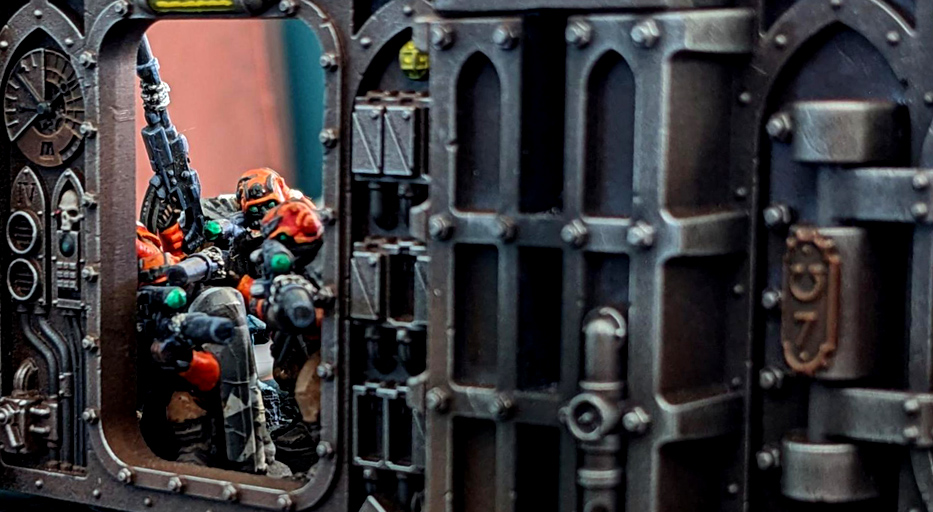
Tactical Maneuvers
Tactical Maneuvers are unique to Boarding Actions, but these function very similarly to actions in Pariah Nexus games. During the Shooting Phase eligible units will forfeit being able to shoot and charge to do various “actions” that impact the game. The only exception to this is the Operate Hatchway Maneuver. Similar to actions in Pariah Nexus, there are restrictions to being eligible to do a tactical maneuver:
- The unit cannot be Battle-shocked
- The unit cannot be within engagement range of enemy models
- The unit did not advance or fell back this turn
- The unit did not get set up this turn (via Deep Strike or another rule)
Secure Site: Only Battleline units are eligible to do this maneuver in the Command Phase on an objective you control. At the beginning of that player’s next command phase, if you still control that objective, the unit that did the Secure Site maneuver will Seize the objective, causing it to be Secured. A Secured objective stays under your control even if no friendly models are nearby, until opponents take that objective by beating you in objective control.
Set to Defend: A blast from the past, Set to Defend allows you to prepare for the opponents Fight Phase by giving you +1 to hit until the end of your opponent’s next turn.
Set Overwatch: This is notably not a stratagem in Boarding actions like it is in standard play. Whenever an opponent’s unit ends a normal move, advances or falls back, declares a charge, or opens a hatchway. A unit that did this tactical maneuver may fire at that target, hitting on unmodified 6s, and can only target that enemy unit. This means multiple units can overwatch per turn (though each unit can only fire once), but to do so they give up their shooting in the Shooting phase.
Operate a Hatchway: During the movement phase, when a unit ends their move within 1” of a hatchway, they can operate a hatchway. This will either open or close the hatchway depending on the state of the hatch. If an enemy unit happens to be within 1” of that hatchway the opponent can choose to stop the hatchway from operating by doing a roll off, adding toughness to the roll, if the player operating the hatchway beats their opponents score (meaning ties go to the opponent) the door operates, either opening or closing, depending on its current state.
As with the previous edition of boarding actions, if operating a hatchway results in you ending in engagement range of enemy models (which is 2” through the hatchway) those units are now in combat but your unit doesn’t count as having charged.
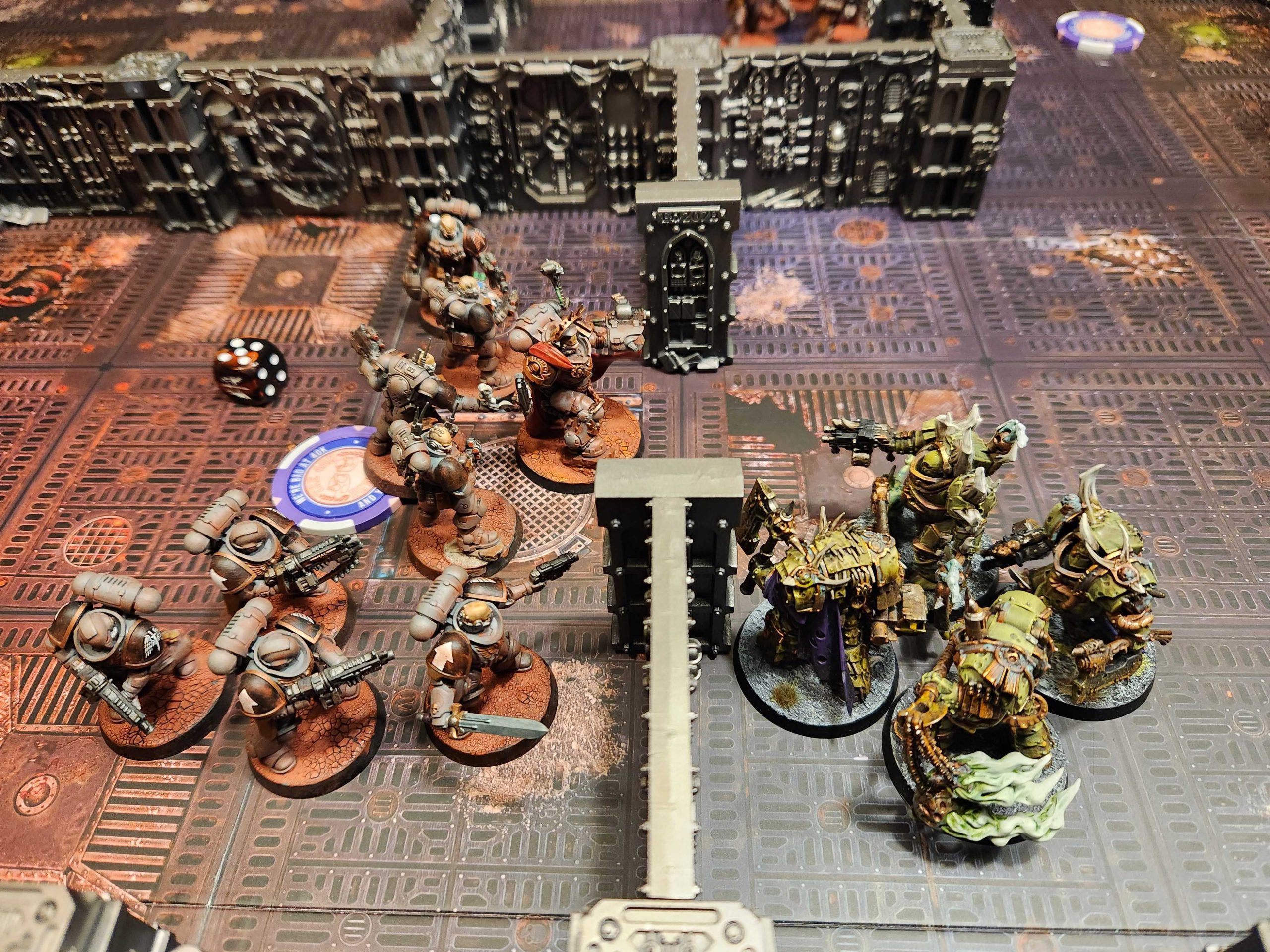
Stratagems
There are five core stratagems for boarding actions before you get into detachment specific stratagems.
- Command Reroll 1CP: It pretty much operates like any other command re-rol, allowing you to re-roll various types of rolls in each phase. (Note: Boarding Actions does not use the rules commentary & errata, but we would consider using it for this stratagem as it relates to fast dice rolling).
- Battlefield Command 1CP: As mentioned above, this is how you can take advantage of your leader abilities. During any phase you can apply one of your leader abilities to a bodyguard unit they can normally attach to until your next command phase. The caveat is you have to be within 6” when you do so, so be prepared with your positioning. You also can’t use this stratagem again until your next Command phase.
- Counter Offensive 2CP: The same as the core rule book stratagem. Allows you to fight immediately after an opponent’s unit has fought.
- Insane Bravery 1CP: Written like the original stratagem for Insane Bravery, you can use this to pass a failed battle-shock test. (Note: Like the Command Reroll stratagem, I would consider using the errata’d rules for this stratagem.)
- Explosive Clearance 1CP: During your Shooting Phase you can select one model equipped with a [Blast] weapon, when determining how many models apply to the rule, you can include models not visible too. This gives the [Blast] rule some new life in this format since being able to do that lets the extra shots pop off more easily and messes with the standard gameplan of trickling out dudes so they all don’t get shot off the table.
Note that Firing Overwatch isn’t among these – that’s because in Boarding Actions units fire Overwatch as a Tactical Manoeuvre, and have to give up shooting in their Shooting phase. Also absent here are Heroic Intervention and Grenades, so you that keyword won’t do you much good in this mode – and the units who make use of it won’t be as effective.

Enhancements
Enhancements are slightly different in Boarding Actions compared to normal 40k. They still go on a character conferring extra abilities, but they don’t cost any extra points. Instead you just select two to give two characters (you can’t stack ’em on the same character or repeat enhancements). The core rules give you a suite of six enhancements to choose from in addition to the ones you’ll get as part of your detachment.
- Superior Boarding Tactics: This one simply gives your two extra CP at the start of the battle. This is a strong one but maybe not as strong as you might think. Most boarding actions games will not have you make contact with the enemy until rounds two to three so you’ll be swimming in CP by the time you get to brawling.
- Close-Quarters Killer: Gives you re-roll wounds in melee. Not a lot to talk about here, very strong on certain characters.
- Peerless Leader: Once per battle round you can use the Battlefield Command Stratagem without spending a CP and even if someone else was targeted with it earlier. This is great for those support characters who don’t do a whole lot without their leadership abilities.
- Expert Breacher: The bearer can attempt to operate a Hatchway at the start or end of the Move Units step of your Movement phase. This is the gold standard for Enhancements and should be what evaluate your other choices against. The ability to open a door before moving another unit through the hatch can accelerate your game plan by an entire turn and gives you the ability to out maneuver your opponent.
- Personal Teleporter: The bearer gets the Deep Strike ability. This can be useful but it’s worth noting this character will be striking solo since they can’t join units. Make sure it goes on a character happy to be flying solo, or has a unit coming in with them.
- Trademark Weapon: Pick a weapon equipped by the character and increase its Strength and Damage by one. Unlike last edition this can’t go on torrent weapons, RIP my Foul Blightspawn combo. This is still pretty strong especially if you have something that hits a lot and reliably.
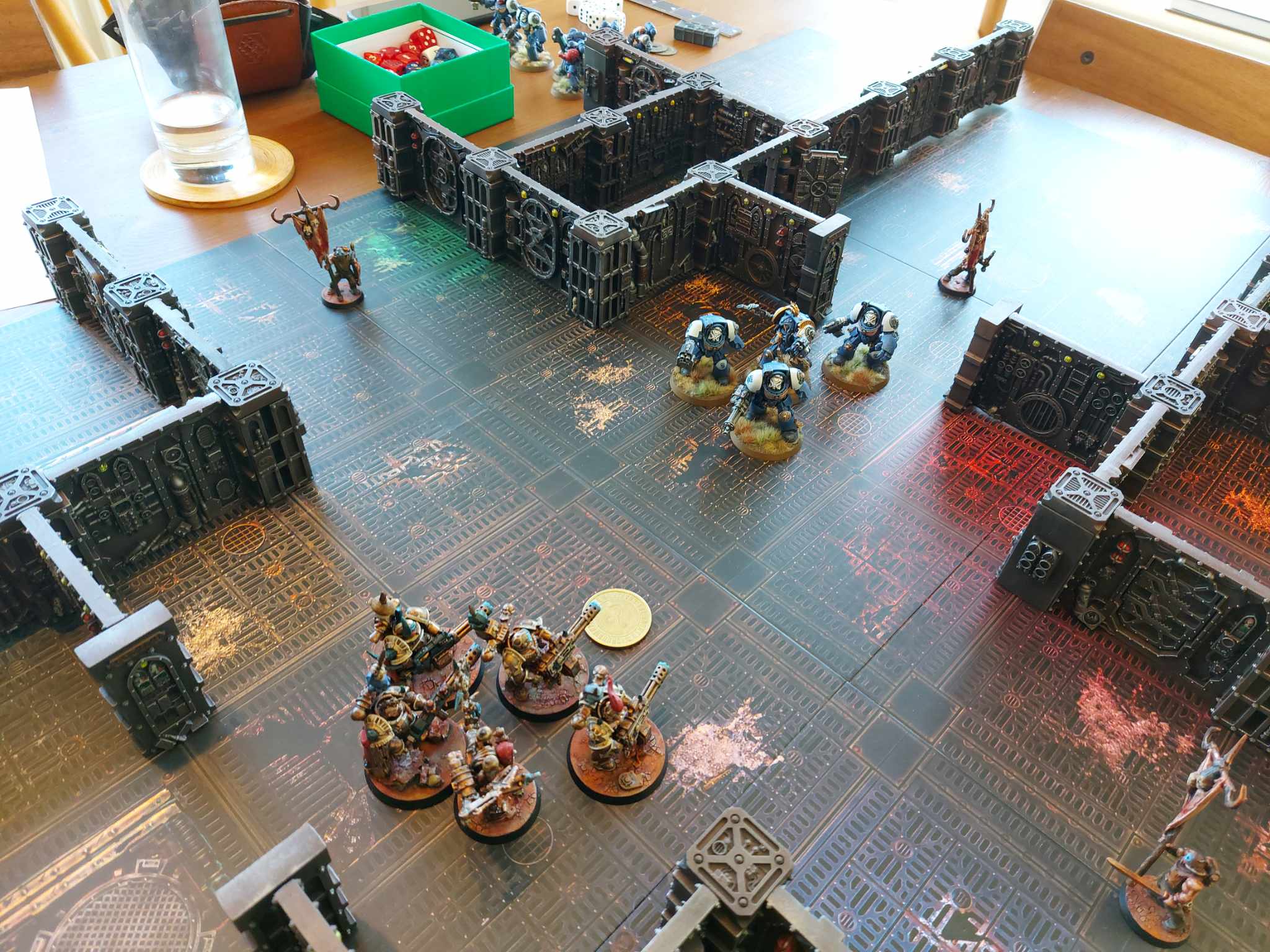
Missions
This book has a staggering 55 missions to choose from. They’re all compiled from the past Arks of Omen books and aren’t changed outside of updating the wording so it works within the 10th edition framework. You can check out our reviews on those books for our takes on the missions. The missions are also divided into categories depending on their style of play.
Symmetric Missions: Missions designed to be played with both players on equal footing. The closest you’ll get to Matched Play in a Boarding Actions context (Source: Arks of Omen Abaddon)
Asymmetric Missions: These missions are all designed to have each player start in different positions or giving them different goals to accomplish. These are great for adding a little spice to otherwise standard missions. (Source: Arks of Omen: Angron)
The Rock Besieged Campaign Missions: These missions follow a narrative throughline of one player attacking the Dark Angels flagship, The Rock, and the other player defending it. Each subsequent mission will have different effects depending on the winner of the previous game. (Source: Arks of Omen Vashtorr)
Narrative Missions: These are missions designed to put both players in set piece situations with big twists, like angron blowing apart the spaceship you’re fighting on. These are for players who are more interested in being surprised by the stuff they’re playing as opposed to going in with a plan. (Source: Arks of Omen: The Lion)
Breaching Operation Missions: So these are kinda just more normal-ish missions with a small twist: you can blow up walls. You’ll get no complaints from me because that’s badass, but these are really only in a different category because they were in a different book and they use the Kill Team: Soulshackle terrain. (Source: Arks of Omen: The Lion)
Dark Depths Missions: The Dark Depths stuff on the other hand is weird. These missions add an extra step to the list building process, picking what half the board looks like. There’s a set of 8 layouts to choose from and you and your opponent just smash ’em together to make boards. This offers a really interesting aspect to your list building because it lets you plan out your first few turns, knowing just how much your list can move and what they’ll have to move through. This is probably your best pick for hosting an event of boarding actions, since the players can just keep their board halves throughout the event. (Source: Arks of Omen: Farsight)
Multiplayer Missions: These are pretty straight forward, they’re rules for playing boarding actions with more than two players. Fun for a change of pace and the rules carve outs help it from feeling too cramped. (Source: Arks of Omen: Farsight).
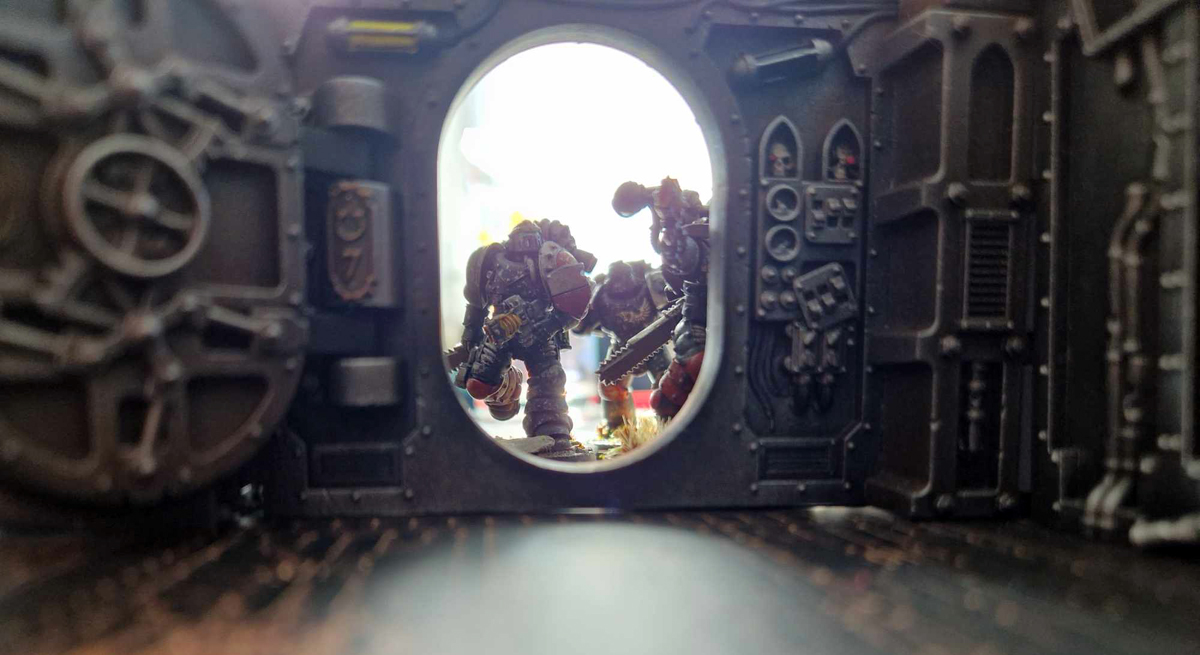
The Verdict
TheChirurgeon: This rules update is basically everything I wanted out of a tenth edition boarding actions update, save a new, easier-to-reconfigure terrain kit. Boarding Actions was maybe my favorite way to play 9th edition and this new update does the same thing. The biggest help here is the Detachments limiting what you can bring in your army – this helps avoid some of the clunky army construction rules we had last edition and turns the detachments into something much more uniform and easy to work with from a balance standpoint. The Detachments we have cover almost all of the bases in the game, though there are a few notable missing elements – not having a detachment with Deathwatch Veterans is extremely lame, and at the same time having Deathwatch Terminators, a unit no longer available, points to how this was likely designed separate to Codex: Imperial Agents and so hopefully we’ll see some corrections to this in an upcoming FAQ/Errata document.
Simply put, Boarding Actions is a ton of fun and this book is great. I’m picking up a copy when it releases and I’ll be figuring out how to incorporate it into future Crusade campaigns I run. I honestly hope they provide more support for the game mode moving forward, both in the form of reprinted white dwarf missions and also additional detachments/PDFs when new codexes and units release. I just want them to keep supporting it!
Norman: Not only does this bring the best alternative format from last edition to this one, it improves it in major ways. The overall design gets a bit sleeker and everything we loved from last edition is here (although I do hope the White Dwarf missions get ported over at some point). The biggest boon here is definitely the new army construction stuff, the detachment system allows the designers to really fine tune how each army can play and put stop gaps to allow them to explore different themes per army. It also means they can add these kinds of detachments with minimal lift while providing a completely different play experience (please give me my Vashtorr detachment back). Overall I’m really stoked to get back into the cramped hallways of the Boarding Actions terrain and fire overwatch with my Foul Blightspawn.
Andrew: I’m very excited to see Boarding Actions come back with a more substantial revision. When 10th edition launched and they were spewing out index after index you could tell boarding actions got left in the wayside. Missions didn’t require much changing, and the minor tweaks to make it line up with 10th feels great. Going over detachments there some really flavorful detachments available for some armies. But most of all, I’m excited I don’t have to carry 6 hardcover books anymore.
Final Thoughts
We’re really glad to see these rules get updated for 10th since this format is a ton of fun and the best way to play warhammer at 500 points. While a lot of the core stuff here is just recycled content from last edition updated for this edition, that’s really all they needed to do. Hopefully we’ll see more content from supplements/white dwarfs in the future.
One final note – Boarding Actions are already supported in Tabletop Battles, with support for Symmetrical Missions. We’ll be adding more soon, but nothing’s stopping you from going in and playing with these new rules the day they release!
Have any questions or feedback? Drop us a note in the comments below or email us at contact@goonhammer.com. Want articles like this linked in your inbox every Monday morning? Sign up for our newsletter. And don’t forget that you can support us on Patreon for backer rewards like early video content, Administratum access, an ad-free experience on our website and more.
